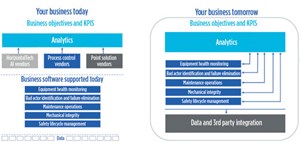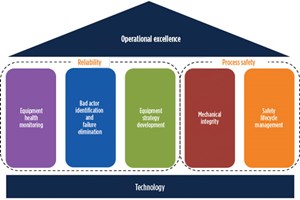Analytics drive operational excellence for business and digital transformation
Digital initiatives and technology spending in the oil and gas industry continue to surge, with 90% of companies increasing spending on digital over the next two years. And 87% indicate that they are using advanced analytics as they look to use data to increase productivity.
Many teams spend a significant amount of time building the upfront business case to substantiate investment in software and analytics, but they fail to implement proper governance to track and measure their progress against the business case. Data science and analytics are powerful tools for any business, but the success and scalability are dependent on getting these insights into the hands of the right people, business functions and work processes that ultimately are tasked with delivering businesses objectives and achieving operational excellence.
What is operational excellence? Achieving operational excellence requires the successful implementation of an integrated business execution system that effectively and seamlessly integrates the following four building blocks:
Strategy deployment—understanding where your company wants to go as a business and what it wants to achieve.
Performance management—define how to measure your business against performing your defined strategy.
High-performance work teams—decide how teams can be enabled and set up to execute your process, to achieve the performance metrics and objectives.
Process excellence—define what your process is going to, internally, to move performance metrics and execute your strategy.
Often, companies are challenged with balancing competing priorities to achieve operational excellence. How do we reduce costs? How do we manage risk? How do we avoid lost production opportunities?
One way to reduce cost is to optimize the cost associated with your operations and maintenance spending. You might optimize spares holding levels using reliability data. Or you can strive to reduce turnaround durations and optimize work scopes to cost-effectively maximize productive time. Managing risk will break down into at least four areas: keeping people and communities safe, avoiding loss of containment events, avoiding regulatory fines, and keeping insurance premiums in check. Lost production opportunities generally boil down to avoiding unplanned downtime and improving capacity utilization to meet market demand more efficiently.
With the emergence of technologies like “AI” and “machine learning,” many leaders have hoped for a short cut to solving age-old challenges that have existed across asset owner operations. In turn, this is where the massive funding for digital and analytics originated. But, as the data tell us, this perceived shortcut, so far, failed to deliver at the levels that management might have expected. And digital transformation initiatives have created a new role in boardrooms around the world—the chief digital officer. A close cousin to the chief information officer, but unlike the CIO, who serves the information technology infrastructure needs of the business, the CDO’s job description is focused on true transformation of the business through technologies that might include data and analytics, as well as the aforementioned AI and machine learning.
Data science and analytics, powered by AI and machine learning, are powerful tools for any business. But the success and scalability are dependent on getting these insights into the hands of the correct people, business functions and work process that ultimately are tasked with delivering business objectives and striving towards operational excellence, Fig. 1.

The road map to success. If operational excellence is the destination, you need a map to get there. How many times have you been part of a software implementation where you look up 12 to 18 months after the system is live and say, “Where’s the ROI? Did we move the needle?” Many teams spend a lot of time building the upfront business case to substantiate investment in software and technology but fail to implement proper governance to track and measure their progress against the business case.
The process of drawing that map to success begins by asking some key questions: What business metrics do you want to move with this initiative? Do you have a plan for measuring progress? What functions exist in the organization that your success is dependent upon? What are those functions’ work processes and is there an opportunity to streamline or standardize them? What systems and types of data are you using and do any of them work together now?
In any asset management organization, you’re going to have key performance indicators (KPIs) that are used to track and understand how effective you are at meeting the needs of the business. These could center around cost, risk reduction, lost production opportunities, etc., but typically these are metrics that ultimately impact the business and the bottom line. These business metrics are lagging indicators of performance and in most cases, this is what business cases are based on for substantiating investment in software and tools to improve.
What often gets overlooked when implementing asset performance solutions are the leading KPIs within a program. There are daily and weekly metrics that the team and various functions can use to determine whether or not you are meeting your goals: Are you using the software and implementing the methodologies and tools within it? And are you responding to information and insights that the technology provides?
It takes a complex and sophisticated web of systems, software work processes, and IT expertise to keep a platform or plant running at full capacity. Although some of these systems work well together, each system is typically dedicated to performing a specific task. They could, however, work more productively and more efficiently. Data must be integrated with a purpose, and with asset performance management (APM) software solutions, multiple systems come together to align these data to work processes and provide analytics at the ground level for more productivity and better decision-making. We’ve found that data integrated from various systems into different views is helpful—strategy, trends, control, geospatial and regulatory are some of these views.
A strategy view can take advantage of enterprise asset management systems like SAP, IBM and Oracle in new and sophisticated ways, to put a strategic lens on risk, maintenance plans, work history and technical asset data characteristics.
For a trend view, condition monitoring and process historian systems can feed data to provide diagnostics and analytics to detect equipment degradation, respond to process events, and make financial strategy decisions.
A control view can integrate with a number of different control systems and edge devices to understand operating conditions that impact assets. HMIs can even be replicated to give asset management personnel the real-time views of the control room.
A geospatial view integrates with a number of different GIS systems to display asset information geographically, including asset health information. This provides a unique visual perspective for distributed asset bases.
A regulatory view will help you to visualize the different global governmental regulations and standards that dictate the way you comply with asset related regulatory codes.
Building the foundation. Work processes are the foundation of any asset management organization. What many decision-makers often don’t consider is the importance of aligning work processes across operations and functions to ensure that the technology deployed within them ultimately supports the requirements of the business and enables them to streamline efforts toward improving KPIs, Fig. 2. APM software can not only break down silos, it also enables an integrated set of capabilities to identify risk, optimize strategies and embed operational analytics to continuously improve leading indicators of business performance.

The final piece of the puzzle on the analytics-driven operational journey is the technology. Once organizational KPIs have been established, data, and work processes, are aligned across the business. Then technology can be deployed to add capabilities to your organizational functions, to make strategic improvements. All organizations have different levels of maturity and resources. As your organization matures, additional capabilities and analytics can be incorporated into your work process to continuously improve and sustain operational excellence.
- Digital transformation/Late-life optimization: Harnessing data-driven strategies for late-life optimization (March 2024)
- The reserves replacement dilemma: Can intelligent digital technologies fill the supply gap? (March 2024)
- Digital tool kit enhances real-time decision-making to improve drilling efficiency and performance (February 2024)
- Digital transformation: Digital twins help to make the invisible, visible in Indonesia’s energy industry (January 2024)
- Digital transformation: A breakthrough year for digitalization in the offshore sector (January 2024)
- Quantum computing and subsurface prediction (January 2024)


